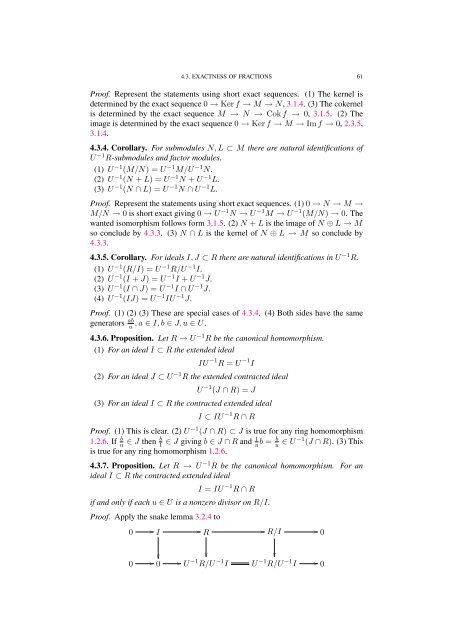Commutative algebra - Department of Mathematical Sciences - old ...
Commutative algebra - Department of Mathematical Sciences - old ...
Commutative algebra - Department of Mathematical Sciences - old ...
Create successful ePaper yourself
Turn your PDF publications into a flip-book with our unique Google optimized e-Paper software.
4.3. EXACTNESS OF FRACTIONS 61<br />
Pro<strong>of</strong>. Represent the statements using short exact sequences. (1) The kernel is<br />
determined by the exact sequence 0 → Ker f → M → N, 3.1.4. (3) The cokernel<br />
is determined by the exact sequence M → N → Cok f → 0, 3.1.5. (2) The<br />
image is determined by the exact sequence 0 → Ker f → M → Im f → 0, 2.3.5,<br />
3.1.4.<br />
4.3.4. Corollary. For submodules N, L ⊂ M there are natural identifications <strong>of</strong><br />
U −1 R-submodules and factor modules.<br />
(1) U −1 (M/N) = U −1 M/U −1 N.<br />
(2) U −1 (N + L) = U −1 N + U −1 L.<br />
(3) U −1 (N ∩ L) = U −1 N ∩ U −1 L.<br />
Pro<strong>of</strong>. Represent the statements using short exact sequences. (1) 0 → N → M →<br />
M/N → 0 is short exact giving 0 → U −1 N → U −1 M → U −1 (M/N) → 0. The<br />
wanted isomorphism follows form 3.1.5. (2) N + L is the image <strong>of</strong> N ⊕ L → M<br />
so conclude by 4.3.3. (3) N ∩ L is the kernel <strong>of</strong> N ⊕ L → M so conclude by<br />
4.3.3.<br />
4.3.5. Corollary. For ideals I, J ⊂ R there are natural identifications in U −1 R.<br />
(1) U −1 (R/I) = U −1 R/U −1 I.<br />
(2) U −1 (I + J) = U −1 I + U −1 J.<br />
(3) U −1 (I ∩ J) = U −1 I ∩ U −1 J.<br />
(4) U −1 (IJ) = U −1 IU −1 J.<br />
Pro<strong>of</strong>. (1) (2) (3) These are special cases <strong>of</strong> 4.3.4. (4) Both sides have the same<br />
, a ∈ I, b ∈ J, u ∈ U.<br />
generators ab<br />
u<br />
4.3.6. Proposition. Let R → U −1 R be the canonical homomorphism.<br />
(1) For an ideal I ⊂ R the extended ideal<br />
IU −1 R = U −1 I<br />
(2) For an ideal J ⊂ U −1 R the extended contracted ideal<br />
U −1 (J ∩ R) = J<br />
(3) For an ideal I ⊂ R the contracted extended ideal<br />
I ⊂ IU −1 R ∩ R<br />
Pro<strong>of</strong>. (1) This is clear. (2) U −1 (J ∩ R) ⊂ J is true for any ring homomorphism<br />
1.2.6. If b<br />
b<br />
1 b<br />
u ∈ J then 1 ∈ J giving b ∈ J ∩ R and ub = u ∈ U −1 (J ∩ R). (3) This<br />
is true for any ring homomorphism 1.2.6.<br />
4.3.7. Proposition. Let R → U −1 R be the canonical homomorphism. For an<br />
ideal I ⊂ R the contracted extended ideal<br />
I = IU −1 R ∩ R<br />
if and only if each u ∈ U is a nonzero divisor on R/I.<br />
Pro<strong>of</strong>. Apply the snake lemma 3.2.4 to<br />
0<br />
0<br />
<br />
I<br />
<br />
<br />
0<br />
<br />
R<br />
<br />
<br />
<br />
U −1R/U −1I U −1R/U −1I <br />
0<br />
<br />
R/I<br />
<br />
0
















